A new study has helped demystify the bad reputation of crows. The research suggests that their notoriety is not entirely merited.

Researchers at the University of Castilla-La Mancha analysed the impact of six species of corvid on a total of 67 species of bird susceptible to being their prey, among which are game birds and passerine birds.
Author Beatriz Arroyo said that in 81 percent of cases studied, corvids did not present a discernible impact on their potential prey and furthermore, in 6 percent of cases, some apparently beneficial relationships were even observed.
According to the study, when crows were removed from the environment, in 46 percent of cases their prey had greater reproductive success, while their abundance fell in less than 10 percent of cases.
Additionally, these experimental studies carried out in nine different countries (Canada, France, Norway, Poland, Slovakia, Spain, Sweden, the UK and the USA) revealed that, if corvids are eliminated but other predators are not, the impact on the productivity of their prey would be positive in only 16 percent of cases; whilst without corvids and other predators, including carnivores, the productivity of other birds improves in 60 percent of cases.
This suggests that crows, ravens and magpies, amongst others, have a lower impact on prey than other threats. Compensatory predation can also occur, the researcher explains.
Advertisement
Source-ANI









